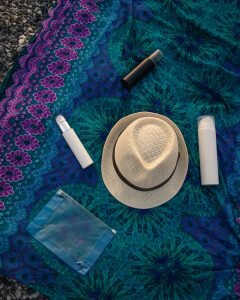
Written by Strategic Insights Expert, Daniel Whitby
In light of last week being Sun Awareness Week – a national campaign run by the British Association of Dermatologists (BAD) to increase awareness of the harmful effects of sun exposure on the skin – one of our Strategic Insights Experts (and member of the Society of Cosmetic Scientists), Daniel Whitby, takes a deep dive into how the sun affects our skin, how we can prevent sun induced damage, and 5 key ways to enjoy the sun safely – including a sneak peek at an upcoming new product launch!
How and why does the sun damage the skin?
Sunlight is composed of ultraviolet, visible and infra-red light. Of most concern in terms of the skin is the ultraviolet light which is composed of UVA and UVB rays.
UVB rays are associated with the SPF value we see on a bottle of sun cream, these are the rays which will result in tanning but also sunburn if we do not protect our skin effectively.
UVA rays are associated with accelerated ageing of the skin including lack of firmness and elasticity, fine lines and wrinkles. To fully understand the effects of sunlight on skin we need to consider the composition of the skin.
The upper layer of the skin, the epidermis, is where cells called keratinocytes are produced. These cells move upwards until they eventually reach the surface of the skin where they form the skin’s outer barrier or stratum corneum. The epidermis also contains melanocytes, specialised cells which release the pigment melanin when exposed to UVB rays – this is why we tan when we have been out in the sun. The primary function of the epidermis is to act as a barrier, keeping moisture in and the external environment out.
Underneath the epidermis is the dermis which forms the inner layer of the skin and is much thicker than the epidermis. The primary role of the dermis is to support the epidermis and provide firmness and elasticity to the skin. The fibroblast is the major cell type of the dermis and its main function is to synthesise collagen, elastin and the viscous gel within the dermis (it is this gel which contains, amongst other things, hyaluronic acid).
Collagen – which gives the skin its toughness and strength – makes up 70% of the dermis and is continually broken down and replaced whilst elastin fibres give the skin its elasticity.
UVB rays can only penetrate into the epidermis but UVA rays can penetrate deep into the dermis where they impair fibroblast function and cause the breakdown of collagen and elastin. This results in a poorly formed dermis which can no longer support the epidermis properly leading to saggy skin with fine lines and wrinkles, a phenomenon known as photoageing.
UVA is also responsible for the generation of Reactive Oxygen Species (ROS) which result in oxidative damage to the proteins and lipids in the skin through the production of free radicals (highly reactive molecules linked to ageing). This damage can be countered by using skincare products which contain anti-oxidants combined with anti-oxidant supplements.
It is estimated that long term exposure to the UVA light from the sun results in between 80 to 90% of visible skin ageing, so it is important to protect the skin from UVA rays to prevent premature ageing and also UVB rays to prevent burning. Sun protection products containing filters which absorb UVA and UVB rays are termed broad spectrum products.
How can sun damage be prevented?
To combat the effects of photoageing moisturisers which offer broad spectrum protection and contain UVA filters and an SPF of at least 25 should be used daily to protect the skin and the components of the dermis – for full protection a dedicated SPF 50 product is also advised to be used daily even in winter. Products which stimulate fibroblast activity through the use of innovative signalling technology, such as the nano gold technology in the Endor Technologies range, will ensure collagen and elastin levels are optimised.
Soon to be launched is elénzia Skin™, an exclusive, new nutritional supplement specifically formulated to protect and repair the skin from within.
The unique formulation bridges the gap between nutrition and topical skin care regimes by internally reducing the negative impact caused by external stressors such as UV rays and air pollution, which in turn reduces skin inflammation, photoageing, wrinkles, excessive dryness and skin dullness to keep your skin looking healthy and youthful.
By combining new patented ingredients clinically trialled and shown to improve skin tone, increase collagen synthesis and reduce the skin’s signs of ageing, elénzia Skin™ feeds your skin to enhance its external glow.
5 ways to enjoy the sun safely, and get a healthy level of Vitamin D:
Understand your level of risk
Using the Fitzpatrick scale is a way of classifying your skin type according to the effect that ultraviolet radiation would have on your skin. You should take more care in the sun if you have one or more of the following: skin that burns easily, light or fair coloured skin, hair, or eyes, lots of moles or freckles, a history of sunburn or a personal or family history of skin cancer.
Use Sunscreen
A sunscreen product with UVA filters and an SPF of at least 25 should be used. You should apply sunscreen 30 minutes before you go out, and make sure to reapply it regularly throughout the day. Use 1 teaspoon full of product for the face and neck, 2 teaspoons to cover your face, arms and neck, and 2 tablespoons if you’re covering your entire body while wearing a swimming costume (NHS guidance).

Seek the Shade
Spend time in the shade or stay inside when the sun is strongest. In the UK, this is between 11am and 3pm from March to October.
Cover up with Clothing
Wear clothes and sunglasses that provide sun protection, such as: a wide-brimmed hat that shades the face, neck and ears, a long-sleeved top, trousers or long skirts in close-weave fabrics that do not allow sunlight through, and sunglasses with wraparound lenses or wide arms with the CE Mark and British Standard Mark 12312-1:2013 E.

Vitamin D Production
It is possible to make enough Vitamin D from being out in the sun for very short periods of time each day. A recent study showed that even with regular and appropriate application of sunscreen there was excellent synthesis of Vitamin D.
References : D’Orazio, John et al. “UV radiation and the skin.” International journal of molecular sciences vol. 14,6 12222-48. 7 Jun. 2013, doi:10.3390/ijms140612222
Credit for Blog Post Elenzia Products




